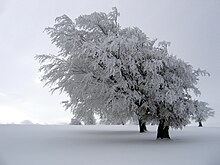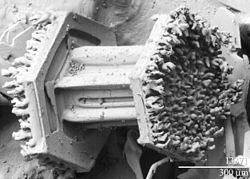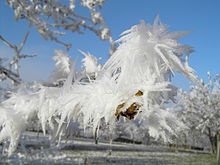This article needs additional citations for verification .(January 2025) |


Rime ice forms when supercooled water droplets freeze onto surfaces [1] . In the atmosphere, there are three basic types of rime ice:
Contents
- Soft rime forms when supercooled water freezes under calm wind conditions. It is milky and crystalline, like sugar, and similar to hoar frost [2] [3] .
- Hard rime forms by rapid freezing of supercooled water under at least moderate wind conditions. The droplets freeze more or less individually, leaving air gaps. [4] [3]
- Clear ice forms by slow freezing of supercooled water. Clear ice is typically transparent and homogeneous. Its amorphous and dense structure makes it adhesive.
Soft and hard rime are less dense than clear ice and less adhesive, thus generally cause less damage. Glaze ice is similar in appearance to clear ice, however it is the result of a completely different process, occurring during freezing rain or drizzle.
Rime ice also forms when ice forms on the surface of an aircraft, particularly on the leading edges and control surfaces when it flies through a cloud made of supercooled water liquid droplets. Rime ice is the least dense, milky ice is intermediately dense and clear ice is the most dense. All forms of ice can spoil lift and may have a catastrophic effect on an airborne aircraft. These hazardous effects are due to the ice's ability to disrupt airflow, increase weight, and add drag. Ice forming on propellers or engine inlets are especially dangerous as it can cause severe vibration and/or damage if ingested. [5]



